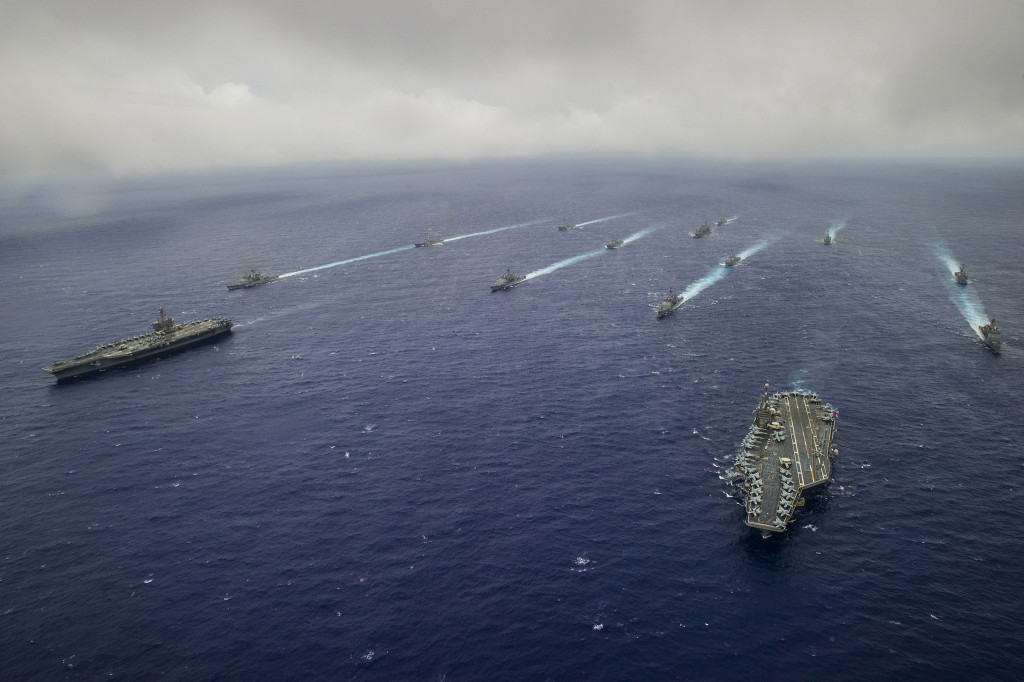Happy Birthday to the U.S. Navy

The U.S. Navy turned 239 this week. Its birthday offers a natural time to consider the point of the Navy. While the answer “protecting America and defending its way of life,” concisely describes the Navy’s ultimate purpose, it does little to illuminate what the Navy does. This question over mission has arisen time and again since the Navy was created in 1775, when the main aims of our naval forces were to protect trade, defend coastal towns, and strike back against the British wherever and whenever the odds were favorable.
The truth is the Navy has no singular mission. It never has. It only seems so when one of its missions resonates deeply with the American public, such as being prepared to defeat the Soviets at sea, and other missions become afterthoughts in the public mind. Today is not such a day. Today, it is readily apparent that the United States requires its Navy to be the most versatile branch of the military. The Navy is providing missile shields in Europe and Asia, launching strikes against ISIL in Iraq and Syria, conducting raids against terrorists in Libya and Somalia, and patrolling in Afghanistan and the skies above. It is the first on scene for disaster response operations around the world, it is the most important leg of the nuclear triad, it is deterring Chinese and North Korean aggression and preparing to defeat it, and it is protecting trade throughout the Indo-Pacific. This is the condensed list of things the nation asks the Navy to do.
Yet most Americans do not really know the Navy. As Gallup polls show, throughout the last decade of conflict in Iraq and Afghanistan most Americans view the Navy as the least important and least prestigious branch of the military. While the Navy may be nation’s Swiss Army Knife, with capabilities to match an array of contingencies and missions, many Americans lack an understanding of this full range and often attribute Navy actions to other services. Critics have noted that this range of missions is hard to capture in a pithy statement of purpose or succinct strategy (others have noted that it’s harder still when the intellectual pursuits of its officer corps are curtailed). But beyond the issue of better public awareness campaigns, the reality is that with so many missions and no single problem set to square off against, the Navy by necessity attempts to make its strategic choices by prioritization. These efforts are not always as successful as they can be. They are often overridden by the Department of Defense or the White House in mission selection, and by Congress in setting new funding priorities. Constitutionally, this is what is supposed to happen.
The problem is that the tools in the Swiss Army Knife can become dulled and rusted without proper attention and maintenance, and as the Gallup polling indicates the Navy has an attention problem. Further, Bryan McGrath correctly points out the Navy is, to a degree, a victim of its own success in successfully taking on the missions the nation asks without enough capacity by sacrificing its ability to meet missions in the future, another fact that is hard to highlight.
There’s not much on the abridged list of Navy missions that I’d assign a low priority or assign to another service, besides perhaps our augmentation of the ground efforts in Afghanistan. Additionally, I see the Navy’s versatility and adaptability as a great strength in dealing with the as-yet unknown dangers of the 21st century. So maybe this week, in honor of the Navy’s birthday, instead of asking philosophically what the Navy is meant to do, take some time to explain what the Navy really does do, why it’s important, and why it’s important for it to have the capability and capacity it needs to succeed.
Scott Cheney-Peters is a surface warfare officer in the U.S. Navy Reserve and the former editor of Surface Warfare magazine. He is the founder and president of the Center for International Maritime Security (CIMSEC), a graduate of Georgetown University and the U.S. Naval War College, and a member of the Truman National Security Project’s Defense Council.
Photo credit: Official U.S. Navy Imagery

